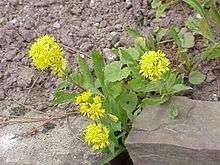Solidago virgaurea
| Solidago virgaurea | |
|---|---|
 | |
| Solidago virgaurea minuta | |
| Scientific classification | |
| Kingdom: | Plantae |
| (unranked): | Angiosperms |
| (unranked): | Eudicots |
| (unranked): | Asterids |
| Order: | Asterales |
| Family: | Asteraceae |
| Tribe: | Astereae |
| Genus: | Solidago |
| Species: | S. virgaurea |
| Binomial name | |
| Solidago virgaurea L. | |
| Synonyms[1] | |
|
Synonymy
| |
Solidago virgaurea (European goldenrod or woundwort) is an herbaceous perennial plant of the family Asteraceae. It is widespread across most of Europe as well as North Africa and northern, central, and southwestern Asia (China, Russia, India, Turkey, Kazakhstan, etc.).[2][3][4] It is grown as a garden flower with many different cultivars. It flowers profusely in late summer.
Solidago virgaurea is a perennial herb up to 100 cm (40 inches) tall, with a branching underground caudex and a woody rhizome. It produces arrays of numerous small yellow flower heads at the top of the stem.[3]
- Subspecies and varieties[1]
- Solidago virgaurea subsp. alpestris (Waldst. & Kit.) Gremli
- Solidago virgaurea subsp. armena (Grossh.) Greuter
- Solidago virgaurea subsp. asiatica Kitam. ex Hara
- Solidago virgaurea var. calcicola Fernald
- Solidago virgaurea subsp. caucasica (Kem.-Nath.) Greuter
- Solidago virgaurea subsp. dahurica (Kitag.) Kitag.
- Solidago virgaurea subsp. gigantea (Nakai) Kitam.
- Solidago virgaurea var. insularis (Kitam.) Hara
- Solidago virgaurea subsp. jailarum (Juz.) Tzvelev
- Solidago virgaurea subsp. lapponica (With.) Tzvelev
- Solidago virgaurea subsp. macrorrhiza (Lange) Nyman
- Solidago virgaurea subsp. minuta (L.) Arcang.
- Solidago virgaurea subsp. stenophylla (G.E.Schultz) Tzvelev
- Solidago virgaurea subsp. talyschensis (Tzvelev) Sennikov
- Solidago virgaurea subsp. taurica (Juz.) Tzvelev
- Solidago virgaurea subsp. turfosa (Woronow ex Grossh.) Greuter
- Solidago virgaurea subsp. virgaurea
- Solidago virgaurea var. virgaurea
Medicinal uses
This plant was cultivated in the Arab world, who used it in their medical system. In the fifteenth and sixteenth centuries it was used in Europe to heal wounds. It has astringent, diuretic, antiseptic and other properties.
Modern herbalists also use it to treat catarrh and kidney stones.[5] It is blended with other tonic herbs to cleanse or "flush" the kidneys and bladder, either as part of a healing fast, or to treat cystitis. In the case of a fast, it is made into a combined tincture as noted, taken with a supporting blend of herbal teas, and grape or watermelon juice is drunk through the day, alternating with Potassium broth.[2]
References
- 1 2 The Plant List, Solidago virgaurea L.
- ↑ Altervista Flora Italiana, Verga d'oro comune, Solidago virgaurea L. includes photos and European distribution map
- 1 2 Flora of China, Solidago dahurica (Kitagawa) Kitagawa ex Juzepczuk, 1959. 兴安一枝黄花 xing an yi zhi huang hua
- ↑ United States Department of Agriculture, Germplasm Resources Information Network (GRIN)
- ↑ Howard, Michael. Traditional Folk Remedies (Century, 1987), p.145